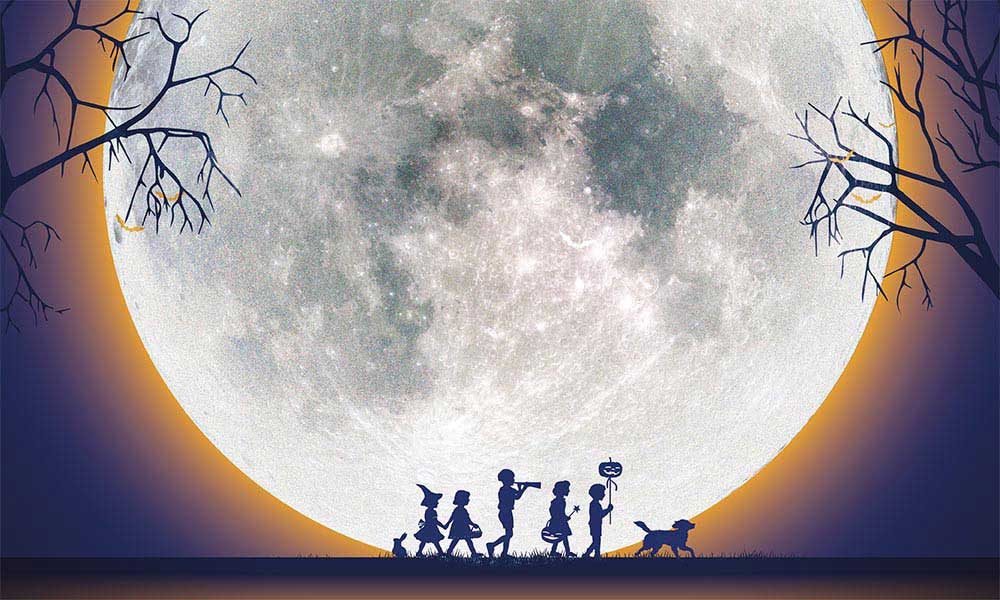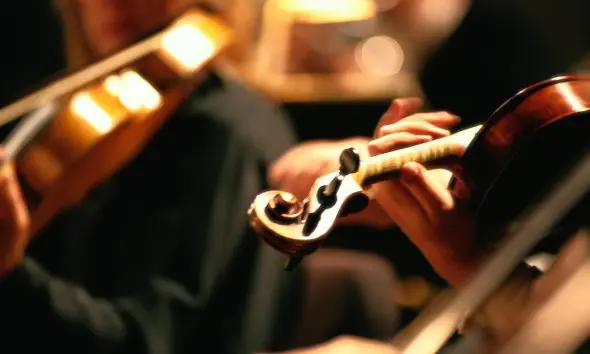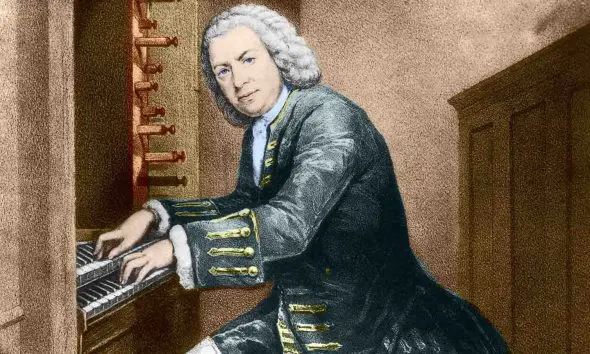Best Classical Music For Halloween: Top 20 Most Terrifying Pieces
Discover our selection of the best classical music for Halloween featuring the scariest classical music ever composed.

On a cold, dark, winter’s evening, set the scene with the perfect classical Halloween soundtrack. We’ve unearthed the top 20 totally terrifying pieces from the darkest, grisliest corners of the classical canon. Scroll down to discover our selection of the best classical music masterpieces for Halloween – if you dare!
Listen to Halloween Classics on Spotify and scroll down to discover our selection of the best classical music for Halloween.
20: Prokofiev: ‘Montagues and Capulets’ from Romeo and Juliet
Prokofiev’s ballet Romeo and Juliet is a dramatic musical interpretation of Shakespeare’s tragedy. The well-known theme from ‘Montagues and Capulets’ depicts the dreadful conflict between these families, which, as we all know, has lethal consequences. The music is driven by an imposing brass section, which marches slowly and somberly, whilst gravelly strings and military-like percussion add a grim sense of foreboding. This piece is also guaranteed to strike terror into the hearts of prospective business partners (as it’s famously used as the theme tune for the BBC show The Apprentice).
19: Dvořák: The Water Goblin
The Water Goblin, an impish symphonic poem, makes for ideal Halloween listening. Dvořák was inspired by this malicious creature of European folklore, said to be responsible for drownings in his watery kingdom, and in particular a poem by Karel Erben. In Erben’s telling of the tale, the goblin kills his own child as punishment for his wife, who escaped him. Dvořák’s characterful score features skittish strings, which creep and leap about, underpinned by harmonic clashes and cruelly-intended brass.
18: Purcell: ‘When I am Laid in Earth’ from Dido and Aeneas
A haunting meditation on the inevitability of death. Having resolved to end her own life, this aria, known as ‘Dido’s Lament’, is an outpouring of grief. The angelic soprano floats hopelessly over a slowly chromatically descending ground bass. The poignant phrase, “remember me” is repeated throughout, etching itself into the memory and returning to haunt the listener from beyond Dido’s grave.
17: Ravel: Gaspard de la Nuit
Ravel’s devilishly beautiful, daringly difficult, piece for solo piano is based on a set of poems and drawings by Aloysius Bertrand, where ‘Gaspard’ is a moniker for Satan. The first movement, Ondine, musically describes a water nymph’s attempts to seduce a man; the second, Le Gibet, depicts the corpse of a dead man hanging on a gibbet; and finally, Scarbo, is about an evil goblin who torments his victims with terrible tricks. In the composer’s own words: “Gaspard has been a devil in coming, but that is only logical since it was he who is the author of the poems.”
16: Shostakovich: ‘Allegro’ from Symphony No. 10
Shostakovich is renowned for his experimentalist, modernistic idiom, as the third movement of his epic tenth symphony attests. A nightmarish headache for performers, this piece is a swirling cacophony of freakish noises: manic strings, shrieking woodwind, grating percussion, angular brass and a whirlwind of uncomfortably unresolved harmonic progressions. Guaranteed to add drama and theatre to your Halloween.
15: Ligeti: Atmosphères
Ever the modernist, Ligeti’s Atmosphères tears up the rule book and is perhaps more of a foray into sound design than a piece of classical music. Dense, scraping textures, experiments with timbre and harmonic clusters make for a chilling, nails-down-a-blackboard feel to the piece, with no sense of rhythm or metre to guide the lost, vulnerable listener. Perfect for spooky scene-setting – indeed Atmosphères famously featured in Stanley Kubrick’s film, 2001: A Space Odyssey – and one of the best pieces of classical music for Halloween.
14: Schubert: Der Erlkönig
Der Erlkönig is one of Schubert’s grislier lieder. The text of Johann van Goethe’s poem tells a tale of a child and his father, pursued by a supernatural being, the Erlking. Schubert paints Goethe’s text vividly: the notoriously fiendish piano part depicts the relentless beating of horse’s hooves, whilst the voice captures increasingly frantic cries from the child and the sweet luring tones of the Erlking, who eventually claims the boy’s life.
13: Rachmaninov: Isle Of The Dead
In this ghostly symphonic poem, one of the best pieces of classical music for Halloween, Rachmaninov creates a stunning yet desolate sonic landscape through masterful use of instrumentation and musical symbolism. Swelling lower strings, irregular surges in the 5/8 time signature and deep, shadowy brass depict oars dragging a small boat through the waters surrounding the Isle Of The Dead. The unnervingly quiet introduction is followed by a quotation of the Dies Irae (meaning ‘Day of Wrath’) plainchant, evoking a sense of hopelessness that this journey will inevitably end in a watery grave.
12: Wagner: Concert Highlights from Götterdämmerung
Götterdämmerung (‘Twilight of the Gods’) from Wagner’s monstrous Ring Cycle, Der Ring des Nibelungen, is the ideal soundtrack for a spooky Halloween eve. The concert orchestral version is a wicked delight, with Wagner’s complex and twisted compositional idiom showcased in a disturbingly dark orchestral palette. The score is so heavy and dense, with its epic brass section and brusque lower strings, that it barely lets in the light of day.
11: Bach: Toccata And Fugue In D Minor
Something about the opening notes of Bach’s Toccata And Fugue In D Minor instantly strikes fear in the listener. Perhaps it’s the blazing pipes of the Draculean organ, or the eerie silences between phrases. Perhaps it’s the villainous semitonal melody, or the rumbling bass pedals beneath, that will raise the hairs on the back of your neck. Beyond this infamously bloodcurdling theme, Bach composes a dramatic and powerful toccata and fugue, which must be executed with demonic virtuosity.
10: Holst: ‘Mars – The Bringer of War’ From The Planets
Holst’s musical characterisation of the Red Planet is as dramatic and powerful as it is chilling. Holst builds suspense with brittle chugging col legno strings, undulating woodwind, vast crescendi, violent percussion and awesome lower brass. The distinct lack of regular pulse, obscured by the jagged 5/4 metre, leaves the listener feeling insignificant and lost in an orchestral cacophony.
9: Liszt: Totentanz
Meaning ‘Dance of Death’, Totentanz is one of many pieces in Liszt’s oeuvre that points to his fascination with mortality, the afterlife, and the dichotomy of heaven and hell. Totentanz is an unapologetically virtuosic piece for piano with accompanying orchestra, based on the Dies Irae plainchant in 6 variations. In the unrelenting piano part, Liszt plays with light and shade: raging, almost violent passages, with harsh harmonic progressions, are contrasted with lighter, even beautiful, moments.
8: Grieg: ‘In The Hall Of The Mountain King’ From Peer Gynt
The epic finale to Grieg’s ‘In The Hall Of The Mountain King’ is one epic crescendo. The musical narrative follows Peer Gynt on his adventure through the Kingdom of the Trolls. Tiptoeing pizzicato strings introduce the well-known main theme to one of the best pieces of classical music for Halloween. This theme is repeated through and endlessly builds, intensifies, quickens and crescendos through the orchestra into an almighty frenetic climax. Finally, the choir enter as the Peer is carried away by a malevolent king, echoing the words: “Slay him! Slay him!”
7: Chopin: Piano Sonata No.2 In Bb Minor
The third movement of Chopin’s Piano Sonata No.2 In Bb Minor, or as it is better known, The Funeral March is inextricably linked to mortality. The somber, heavy footsteps of the mourners in the bass of the piano are both heart-breaking and blood-freezing: a sound that has become synonymous with death. This cold, jarring theme is developed throughout the movement, momentarily contrasted with a pastoral trio section, before the funeral theme returns, signifying the omnipresent inevitability of death. This is one of the best pieces of classical music for Halloween and one of the darkest Chopin ever wrote: it was also played at the composer’s own funeral.
6: Mozart: ‘Dies Irae’ from Requiem in D minor
Mozart’s Requiem was the last piece he ever wrote: he fell ill during its composition and died before its completion. In a grim, self-fulfilled prophecy, he even commented, “I am writing my own funeral music. I must not leave it unfinished.” This ‘Dies Irae’ is a solemn but mighty setting of the Catholic liturgy, with massive choral forces darkened by intense strings, dense brass and rumbling percussion.
5: Berlioz: ‘Dream Of A Witches’ Sabbath’ From Symphonie Fantastique
Berlioz’s Symphonie Fantastique is a programmatic masterpiece, based on the warped, supernatural fantastical imaginings of a mysterious protagonist. The fourth movement, ‘March To The Scaffold’, portrays the protagonist marching to his execution for the murder of his lover – complete with pizzicato bass solo representative of his decapitated head bouncing to the ground. For the finale, ‘Dream Of A Witches’ Sabbath’, Berlioz wrote in the score, “He sees himself at a witches’ sabbath, in the midst of a hideous gathering of shades, sorcerers and monsters of every kind who have come together for his funeral. Strange sounds, groans, outbursts of laughter; distant shouts which seem to be answered by more shouts.” As the bells strike midnight, these grotesque otherworldly represented by wailing Eb clarinet solo and ominous lower brass theme. That this bizarre narrative is said to be autobiographical makes Berlioz’s narcissistic symphony, which is one of the best pieces of classical music for Halloween, all the more grotesque.
4: Orff: ‘O Fortuna’ From Carmina Burana
‘O Fortuna’ is the immense opening and closing movement of Orff’s cantata Carmina Burana. The theatricality of this piece is what creates the unbearable tension: the quiet, frantic strings, the cold, barely whispering choir, the massive force of the orchestra, but most significantly the sudden eruptions into fortissimo with wailing sopranos and crashing percussion. Used widely in popular culture, perhaps most famously as the soundtrack to the film The Omen, this is as much a piece of production music as it is a classical tour de force.
3: Mussorgsky: Night On The Bare Mountain
Another superbly fantastical narrative, Mussorgsky’s Night On The Bare Mountain is a realist piece that paints a musical pictures of a witches’ sabbath on St John’s Eve. Mussorgsky writes crude harmonies, wild, frenzied strings, bold orchestral effects, and satanic themes that Mussorgsky himself described as “barbarous and filthy”. After a night of chaos, the sunrises over Bare Mountain and the witches vanish, leaving only an eerily tranquil flute solo to end Mussorgsky’s masterpiece.
2: Verdi: ‘Dies Irae’ from Messa di Requiem
This is an utterly petrifying choral masterpiece: few pieces have as an iconic an opening as the ‘Dies Irae’ from Verdi’s Requiem. The unmistakable orchestral stabs and cascade of shrieking voices unleash a musical hellfire upon the listener. A torrent of voices warn of judgement, reckoning and eternal damnation, whilst the orchestra, dominated by trumpets and percussion, hammers home the punishment of eternal damnation for unrepentant souls. Pure Halloween drama.
1: Saint-Saens: Danse Macabre
Saint-Saens explores the supernatural macabre in his chilling orchestral waltz Danse Macabre, one of the best pieces of classical music for Halloween. The soothing chimes of a bell tolling midnight lulls the listener into a false sense of security, until the infamous violin solo. The sole use of the violin’s open strings creates a bare, jarring quality, illustrating the rising of the ghouls from their graves, before morbid frivolities ensue. An enchanting, yet terrifying, Halloween masterpiece.




